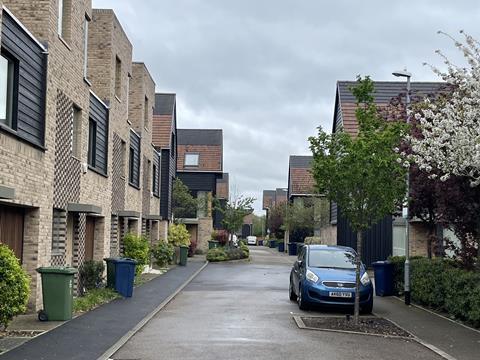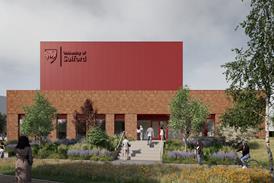A new report reveals how Cambridge overcame barriers to growth and set a new standard for UK housing development, write Stephen Platt

A report has just been published that evaluates housing schemes in Cambridge and the Cambridgeshire Quality Panel’s role in raising quality, and explores potential lessons for other growth areas. The report describes how people in Cambridgeshire overcame the barriers to growth that stifle development and reviews models that increase the number of new homes delivered from each site. It aims to determine if the high standards seen in Cambridge can be replicated elsewhere in the UK.
The intended audience includes ministers in housing, communities, and transport roles, councillors, officers in planning authorities, design review panels, and anyone connected to delivering new housing. The report is supported by the Ministry of Housing, Communities and Local Government and Cambridgeshire County Council.
In 2022-23, Cambridge outbuilt Oxford by a ratio of 6:1 new homes. In previous eras, this might have meant a dash for quantity at the expense of quality. Instead, the area has won 11 Housing Design Awards between 2014 and 2024. Eleven awards betters the aggregate total of awards in England’s 20 largest cities (excluding London), whose combined population of more than 30 million dwarfs Cambridge’s 150,000. What lessons from this rise in quality are relevant to other growth areas?
How did Cambridge do it?
Cambridge embraced growth, overcame nimbyism, and built better. Innovation in the planning process began over 20 years ago with Cambridge Futures, a forum that brought together key people from the University of Cambridge, business, and local government, providing an evidence base for change by modelling seven development options. It tested development options and paved the way for The Quality Charter for Growth and then the Cambridgeshire Quality Panel (CQP).
Public consultation on the options secured political buy-in and local leadership, ensuring that Structure Plan proposals about changes to the Green Belt, densification, and the location of a new settlement did not meet with the kind of opposition that other places experience when proposing big changes.
In accepting growth, the community demanded high quality. The Quality Charter, devised in 2008, provided a framework for assessing new development with 4 Cs: Community, Connectivity, Climate, and Character. In 2010, the Cambridgeshire Quality Panel was formed to review major schemes. To date, the Panel has conducted 100 housing scheme reviews. The Quality Charter and the Quality Panel have had a significant impact on quality. The Quality Panel encourages applicants to go beyond what they are required to do and definitely helps raise the bar on quality in most schemes.
What is the evidence for the report?
The study described in the report was based on six new neighbourhood schemes in and around Cambridge. The key actors in the story – the planners, the applicants and their design teams, and panel members – were interviewed. Panel members then visited the sites and gathered in a workshop to pool their impressions.
The schemes case-studied

Abode at Great Kneighton is exceptionally good. Not only is density high (55 dph) relative to traditional housing estates built at the edge of towns (typically 25-30 dph), but it’s also low-rise. The neighbourhood is intimate, with exceptional landscape integrated with the architecture, and all key services and amenities are provided.
Eddington is also exceptional, but here the University of Cambridge, as landowner and developer, is taking the long view, investing not only in the future of the place it’s creating, but also in the future vitality of university research. There are lessons for other places in the ambition, master planning, landscaping, and build quality of Eddington.

Darwin Green and Marleigh, the other two schemes on the edge of the city, mostly offer a less expensive product, but housebuilders have still raised their game. Darwin Green has suffered from the economic realities of development in challenging times, and essential services – schools, parks, shops, and health centres – are still missing. Both look a little barren and treeless as a result of less sophisticated integration of the design and adoption processes. They are, however, still less than half complete and have the potential to mature.
North Ely and Phase 1 of Northstowe are what Panel members have described as ‘good ordinary’. In North Ely, Hopkins Homes set a high standard of finish in individual homes, although the streetscape is poor. Northstowe will eventually be a town of 25,000 people. On Phase 1, a ‘Northstowe style’ is emerging, with townhouses up to 3 storeys tall with distinctive gable ends, although many homes are more conventional housebuilder 2-storey types.

Northstowe currently suffers from unfinished streets where planting and cycle lanes have been delayed because inhabited streets have been used as haul roads. Both North Ely and Northstowe are less than a quarter complete. In North Ely, it will probably be more of the same, but not the same quality, and in Northstowe, new housing types are emerging with renewed ambition from Homes England for it to be exemplary.
Cambridge has particular advantages. Is this approach relevant elsewhere?
Once the climate of opinion begins to change and people recognise that growth is desirable, it opens the door to discussions on how best to manage change. The Cambridge Futures experience and the concept of the Quality Charter offer a way forward, allowing a community to take ownership of the growth and benefit from improved amenities and infrastructure.
The Quality Charter and the Panel are absolutely replicable and can be adapted to meet local challenges.
Can we build 300,000 new homes a year?
The private sector is well able to deliver 200,000 homes a year. We built 192,000 in 2022 and 212,000 in 2023, about a quarter of which were registered as affordable. We built 245,000 in 2019 before Covid. We used to build an equal number of council and private houses each year. In 1970, local authorities and housing associations built 200,000 homes, and the total number of homes built was over 400,000. Since 1980, however, we haven’t been building much social housing, which is the real need.
If we can win over local support for growth in the way Cambridge did and strengthen and resource the planning system to help speed up the process, it would seem entirely feasible to build 300,000 new homes a year with the necessary infrastructure, including public transport and jobs. The key lesson from Cambridge is that quality matters and that temporary provision should be made for essential community services until there is the critical mass of residents to support permanent provision.
Postscript
Stephen Platt is director of Cambridge Architectural Research Ltd


















1 Readers' comment